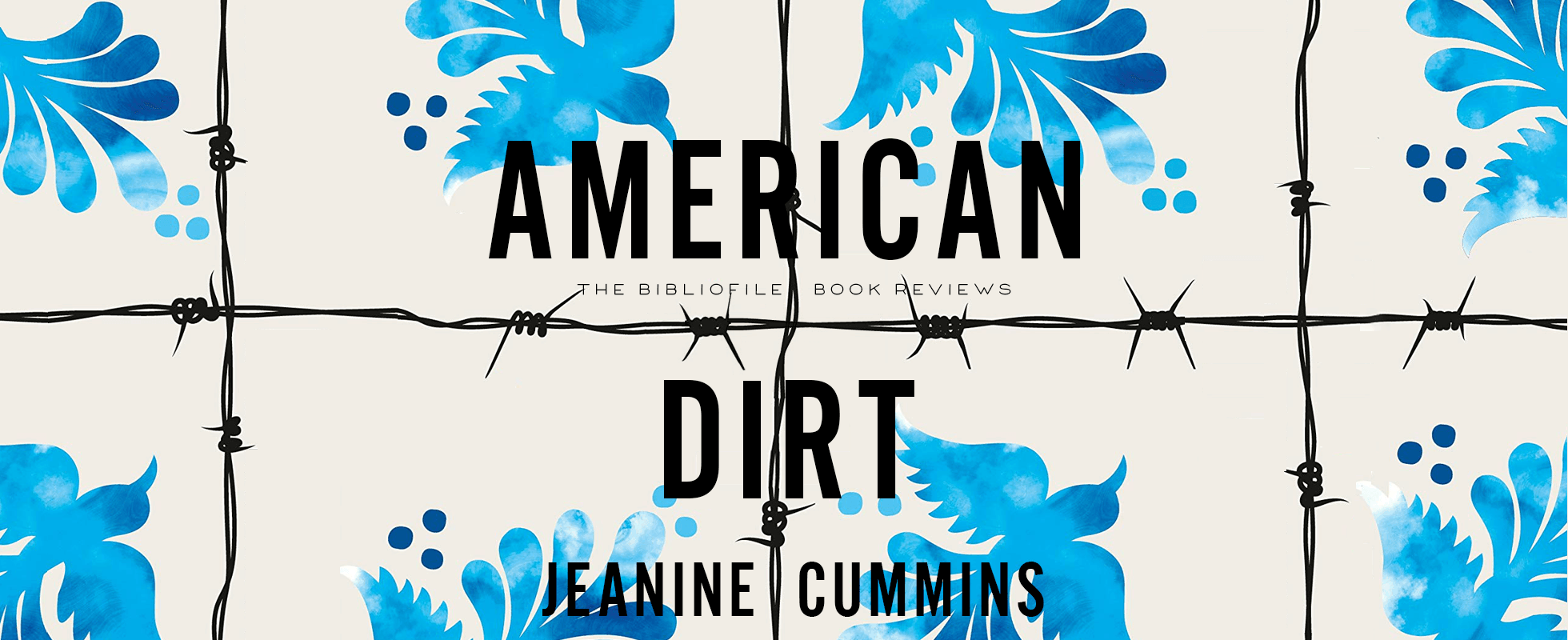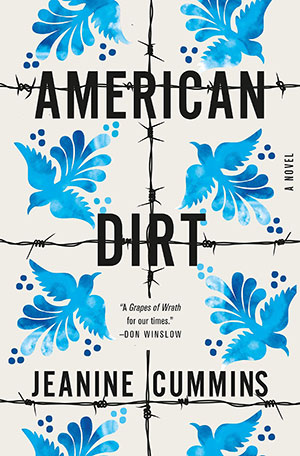American Dirt by Jeanine Cummins has been the most talked about novel of the new decade so far (though keep in mind that I’m writing this in January 2020), for both good reasons and bad. It was sold in what was reported to be a seven-figure deal and has a movie in the works. It also received praise from a lot of big names like Stephen King, Sandra Cisneros, Ophrah and various literary gatekeepers.
As for the negative buzz, well, there’s been a lot of that, too. More accurately, it’s been accused of being a one-dimensional portrayal of Mexico and being exploitative. Commentators have also pointed out factual inaccuracies about Mexico, an over-reliance on stereotypes, and the strange foreign gaze that the Mexican protagonist has.
So, what’s the deal, and should you read this novel? Since most of the reviews thus far have been largely polarized, either a) willfully ignorant of any criticisms, or b) focused almost entirely on its flaws, I was curious to take a look.

Oprah’s Book Club Pick
The Good Stuff
American Dirt is very much a thriller in that there’s plenty of chases, suspense and a lot of action in the novel. The backstory for the characters and the writing are superior to your standard thriller. Parul Segal wrote a review of it that (accurately) lambastes some of the writing as being tortured or otherwise questionable, but honestly it’s still a large step up from your average thriller. It’s maybe a bit long-winded, but really I think most people will be fine with the writing.
If I hadn’t known about the criticisms, it would not have seemed overtly apparent to me that the book was problematic (with some exceptions, see below). There wasn’t a ton that stuck out to me when I first started reading, beyond a standard level of nit-picks. I would have wondered about the accuracy in general, but I wouldn’t know one way or another since I am neither from Mexico or of Mexican heritage.
To be clear, this is not a book where no effort has been made to do any research. Parts of the novel contain many details which clearly are the result of diligent research. For example, there’s much specificity in discussing conditions on La Bestia, a freight train, and the impact of Programa Frontera Sur, a joint U.S.-Mexican funded initiative to keep migrants off the train. And yet, it’s unfortunate that the result is still a book that has some issues (see below).
The book also does try to incorporate a range of experiences and types of migrants in order to paint a fuller picture of the experience of trying to cross the border, though the main focus is on the journey from Mexico (as opposed to from Central America) since that’s where the story is set. It’s clear the plot has been contorted to some extent to bring in these aspects of the story, but I can understand why Cummins would try to do this. I do think she did a good job of working these things into the narrative. (But of course, how accurate any of these depictions are is questionable, so I take it all with a grain of salt.)
Criticisms & Controversy
In terms of the story, there are quite a few questionable plot decisions and characterizations. Everyone is either a murderer/rapist or a saint, and the characters rarely have to make hard decisions. Our protagonist Lydia is especially saintly, and yet also kind of stupid. Why would she think it wasn’t necessary to have any safety precautions with her husband publishing an expose on a cartel boss? Why does she rely on begging for food when she has thousands of pesos on hand and hundreds of thousands in the bank? Why doesn’t she (a middle-class woman) know that you need documentation to ride a plane?
Meanwhile, Lydia’s son Luca is eight years old but says stuff like “your help would be a significant advantage” when asking for help. Luca also lashes out at random guards, criminals and whatnot, and they all laugh it off because they find him so cute and precocious. I’ve never tried crossing the border, but my instinct is that acting brash, but cute is not a great strategy.
A bigger issue that other reviewers have pointed out is Lydia’s “foreign gaze” when it comes to journeying through Mexico. Her reactions do seem oddly similar to how a foreigner would react to situations. Additionally, a noticeably irritating aspect of the story is the repeated references to “brown” skin. It’s just “skin,” okay? Unless there’s something noteworthy about the color, you can just refer to it as “skin.”
Cultural Inaccuracies
In terms of the cultural inaccuracies, I’m not from Mexico or of Mexican heritage so I can’t really assess how accurate the depiction of Mexico is. I will instead rely on what other reviewers have said. Four widely shared articles that are critical of the book can be found here, here, here and here.
For example, an issue that’s been brought up is the stereotypes about Mexico that many feel are pervasive throughout the book. There seems to be a common commentary that it paints Mexico as only being overrun with drugs, crime or corruption and not much else. Furthermore, Cummins throws in a wide range of stereotypically Mexican/Mexican-ish things. Just in the first few chapters, things like quinceañeras, Carne asada, random Spanish words, and so on all make appearances. I’d imagine its similar to if someone wrote a book about an American family that dresses in red, white and blue, eats hot dogs all the time and decorates their house with pictures of eagles.
Another example of the lack of authenticity that has been pointed out by a reviewer on Amazon. The characters wonder why a gang leader is nicknamed “La Lechuza”, which means “the owl”, since owls aren’t scary. The reviewer clarifies that a “lechuza” is more specifically a screech owl that has been considered an omen and harbinger of death in Mexican culture for thousands of years, which any Mexican would know (according to that person).
Of course, the sad fact is that literature, including stuff taught in schools, is rife with inaccuracies and inaccurate portrayals of places or people. Some books, like Conrad’s Heart of Darkness, are blatantly problematic. Others, like Hemingway’s For Whom the Bell Tolls, on further inspection, misrepresent the societies they are depicting and contradict historical records. And then there’s stuff like Robinson Crusoe where it’s a classic but few reading it would assume it was ever meant to be a fact-based story. But these stories all end up shaping our perceptions nonetheless, so it seems like we should be striving for something better.
I also think reviewers should be more honest about what they don’t know. People need to be allowed to write about cultures they are not a part of, or review books from heritages that are not their own. However, when a non-Mexican writer publishes a book about Mexico and a non-Mexican reviewer declares its “authenticity,” any responsible editor should find that highly suspect.
Writing About Other Cultures
As mentioned above, in my opinion, writers must be able to write about people outside of themselves. That said, I think that comes with it the burden of doing the work to portray other cultures or people accurately and responsibly. Furthermore, for sensitive topics, I think that burden is especially high. (If a publisher is worried about that burden, finding writers that have first-hand experience is always an option!)
For example, they have the responsibility to ensure that it’s not full of stereotypes or otherwise exploitative. Unfortunately, American Dirt is guilty of both these things. It leans on stereotypes about Mexico and the treatment of the subject matter feels exploitative to a lot of people. I can certainly see why a publisher choosing to promote a book on a sensitive topic of great importance and relevance without proper diligence would feel extremely exploitative to people who know that place and have lived that pain.
When reporters shove a microphone in someone’s face after they’ve experienced trauma, it’s exploitative. In much the same way, misrepresenting the story and culture of immigrants when those people are currently under attack by U.S. leaders (and using the symbols of their trauma as decoration as parties, see below) shows very poor judgement.
One thing I’ll say in Cummin’s defense is that I doubt she imagined when she submitted the book that it would end up being this large of a release. It’s not to say that it excuses whatever inaccuracies entirely, but I imagine if she’d known it would be so widely read and if she’d had the resources she has now, perhaps some parts of the book would have been shaped differently. And the decision to promote this specific book (over other more authentic voices) is ultimately up to the publisher, not the author. I’ll finally add that I think book twitter has gotten too vitriolic. There is a difference between being critical and being hateful.
More Controversy and Barbed Wire Centerpieces
To make matters worse, the Flatiron Books launch party for American Dirt made the extremely questionable decision to feature barbed wire centerpieces. Honestly, who thought this was a good idea? Would you use nooses as decor to launch a book about America’s racist history? Or small planes as decor for a book about September 11?

Barbed Wire Centerpieces, From Flatiron Book’s American Dirt Launch Party
I don’t doubt that there were many people with only pure intentions in the publishing process. But stuff like this really does reinforce the idea that this is just a big publishing house capitalizing on and exploiting the pain of immigrants without any genuine concern for their plight.
(Author Jeanine Cummins also had a manicure — mirror here in case that link goes down — that many found objectionable.)
Read it or Skip it?
Obviously, a book can be two things at once. American Dirt is a book that tells a well-paced story that is timely and accessible. However, it’s also a book that has many issues and inaccuracies. I wouldn’t rely on it to enhance your understanding of Mexico, and while it does contain some information about the difficulties migrants face, I would also take it all with a grain of salt.
(Furthermore, there are clearly systemic issues that allowed those problems to be ignored on its way to publication. And I think recommending this book without making others aware of the problems with it is a little irresponsible.)
Aside from any cultural stuff, it doesn’t take an expert to know that this story lacks realism in parts. The characterizations are questionable, and there’s an odd lack of hard decisions that need to be made in this situation that necessitates hard decisions. This is not to say the story isn’t suspenseful or interesting for people who enjoy thrillers, though.
I would love to hear others’ opinions on this book! Feel free to drop a comment below. I promise to give any (civil) comment genuine, open-minded consideration, especially when it comes to opposing perspectives. Happy reading!
See American Dirt on Amazon.
Similar Titles
For some other titles dealing in similar territory, check out The Devil’s Highway by Mexican author Luis Alberto Urrea, Fruit of the Drunken Tree by Colombian author Ingrid Rojas Contreras, Children of the Land by Marcelo Hernandez Castillo, or The Affairs of the Falcóns by Melissa Rivero.






What an excellent,and balanced piece this is! Having got my own copy and feeling quite awkward about reading and reviewing it,I absolutely feel you nailed both the issues and the responsibilities so well.
Thank you! and yes, I totally agree this was one of the harder reviews to write given that so many people have strong feelings about it and there’s a lot of external stuff going on around it. Thanks for reading!
It’s refreshing to read a balanced review of this book! It doesn’t sound like something I’ll add to my tbr pile, but I’m happy to have read your review.
thank you and thank you for reading! :)
Interesting review, there is certainly a lot of hype and negative press about the book around.
thank you — yeah there’s definitely a lot of commentary about it right now to sift through!
I kept hearing about all the controversy surrounding this book but didn’t have time to read any articles until today, so yours is the first that I’ve read. I really appreciate your suggestions of other, similar books to read as well as the links to four critics. The first link had some book suggestions. Links 2 & 3 seem to take me to the same article?
It was enough for me to hear all the complaints about the bad writing. I will pass on American Dirt for that reason alone.
I made myself a Goodreads shelf called American Dirt opposition and added the books you and Myriam Gurba mentioned to it.
Hi Jinjer — thank you for letting me know about the messed up links, it’s been fixed! Thanks for reading!
Great!
I agree with the author’s objections to the book. However, I would not say it’s poorly written, not on the sentence level. I find much of the writing to be strong. The metaphors and word choices are often beautiful.
Thank you for this balanced review, Jennifer! I haven’t read this book, nor am I going to soon… But I’m seeing this going on for about a year now, how an author is also abused instead of only criticised. I think these are the pitfalls of a connected age. And the book has been tagged as a fiction, domestic fiction, thriller. What exactly has happened to the understanding of creative liberties? Middle East has been, is still being, in certain respects, misrepresented. But does it mean that we stop reading works of fiction and appreciating them? I’m from India and knowing the reality about my country, if some author only considers one aspect for their book and sweeps aside all the other things, then I won’t of course treat it as a misrepresentation. And in this connected age, neither will anyone else as long as they read the world news! It is, after all, a work of fiction. I don’t understand the hue and cry.
I started reading this book and since I have been living in Mexico for 15 years, could easily see the errors in the plot story. When I realized Lydia was planning to take the train, I stopped reading to question both the author and the purpose of this book. Thanks for your review. When I saw it was a thriller I realized why the author, not understanding Mexico would distort life here. I do think there is some irresponsible actions of promoting this book because the US main stream media publishes so many false statements about Mexico and this book and this book does the same. I don’t plan to finish the book I don’t read thrillers
My OPINION
1. It shows that what happened to Lydia, a misjudgment of character, trusting those on “face” value, Love Is Blind etc, can happen to anyone “in general”.
She was a typical hard working loving mother daughter aunt…that LIFE’s dark side threw curves!
2. It is a “light hearted” look at a horrific topic that too many sheltered people choose to ignore thus I APPLAUD this protected eye opening novel
3. I cannot even watch war or fight sequences and books like this that are too real will not even be given a chance…Luca is a complex character that is delightful and offers a relief and hope just when things need which is not “real”. Unreal books about REAL life circumstance the privileged cannot even begin to ingest let alone digest, crates the perfect taste to wet the appetite for more.
I’m currently reading this book and as someone who is mexican, this book has created mixed feelings for me. I don’t question Jeanine’s freedom of expression, I just wished this book was well researched. There were many missed opportunities through out the book where she could elaborate. I just don’t like the concept of a middle aged woman with lots of money in the bank crossing the country, into the United states and suddenly everything is okay. This book also doesn’t do justice of explaining the beauty that Mexico has. Yes Mexico is controlled by drug cartels, but there is beauty on those lands. There are excellent food options, beautiful buildings from the 1500s, and beautiful beaches. However, I believe this book has become a catalyst for creating the conversation of what is an immigrant, and leading readers to other Latinx stories that are far better than American Dirt.
I was entertained by this book. Though I don’t believe it as a completely accurate portrayal of Mexico and immigrant plight, it still brings awareness to the issue. I think some of the criticisms are justified but I agree with you that they have gotten out of control- some people ARE downright hateful (read Myriam Gurba). I think maybe the people that are uber defensive just don’t like that the dangerous and frightening aspects of their country are being highlighted.
Jules Verne once wrote a book about a submarine. Today we know, that such a submarine cannot be build using the materials he described. It would have not been strong enough to resist the water pressure at the depths he quoted.
So what! Does it make his book less enjoyable? Is it of a lesser value today? And does it matter that Verne could not even swim? How dared he to write about underwater escapades!
I just finished AD,in 3 days, I couldn’t put it down. I also just witnessed the end of President Trumps time in office , and have no doubt that this is the way life has been for the immigrants seeking life here in the USA. This may not represent the entire country of Mexico, but I think it’s a realist read on what immigrants go through to get here. And even worse, what happens if they are detained, now that we all know the realities of his vicious immigration policies. If it is exaggerated at all, so what, it is representive of what an immigrants life is now.
I have lived among many Central Americans and know many Mexicans. I have travelled the whole length of the country by bus. I also have known a woman who has had similar experiences to Lydia. Middle class and who I accompanied to a asylum seeking court appearance because someone was searching for her to kill her. The evidence obtained from Central America was enough to cause the judge to grant her asylum.
I also found that I grew to like many of the characters in the book. I was not judging nor do I judge Mexico. The story i read is only one part of how I view Mexico with its “sympatico” people, rich heritage, hard working people, personable caring friends, lively music, a language I have learned to speak, etc.
Almost every book has flaws, big, small…I liked the book. For me it was an interesting personal story of a mother, son and important influencers. It was not meant to learn about Mexican culture. We know how cartels can work. We learn about them every day!
It’s fiction, for cripe sake. I don’t read fiction in order to expand my knowledge, understanding or perspective of the material. If I wish to acquire knowledge of a particular subject, I don’t resort to fiction to do so.
It’s a so called thriller. I found it long at times, elaborating on the same scenes. Maybe the breakdown of every meal they ingested was of interest to some, but I found it to be maybe more of accomplishing a word count for the author.
All considered, I found the book to be marginally entertaining. I should acknowledge that I read it as a book club assignment. Normally I would avoid any book that Oprah is pontificating on.